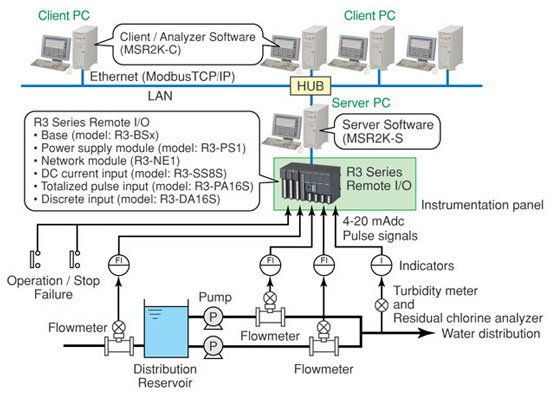 M-System’s
MSR128/MSRpro series is a Windows PC-based recorder software program,
which connects to economical I/O modules such as models RZUS, RZMS, R1M,
R2M, R3 and R5 having inputs of DC mV, mA, thermocouple, RTD/potentiometer
and discrete I/Os. The MSR128/MSRpro is fully featured, enabling the logging,
trending, acquisition and analysis of application data. Combined with
I/O modules, the MSR128/MSRpro provides a low cost industrial grade data
acquisition system. M-System’s
MSR128/MSRpro series is a Windows PC-based recorder software program,
which connects to economical I/O modules such as models RZUS, RZMS, R1M,
R2M, R3 and R5 having inputs of DC mV, mA, thermocouple, RTD/potentiometer
and discrete I/Os. The MSR128/MSRpro is fully featured, enabling the logging,
trending, acquisition and analysis of application data. Combined with
I/O modules, the MSR128/MSRpro provides a low cost industrial grade data
acquisition system.
M-System’s MSRpro is a ‘paperless pen-type’ recording
system for PC-based data acquisition and analysis, supporting a total
of 2048-channel analog and discrete signals. By communicating with I/O
modules that have a LAN card communication interface, the MSRpro reads
input signals and stores them in a hard disk as digital data. The MSRpro
is a suite of three programs: the MSRpro-Server (referred hereafter as
‘Server’), MSRpro-Builder (‘Builder’), and the MSRpro-Client/Analyzer
(‘Client’).
This software package provides a simple solution while still maintaining
the wide versatility of available types of signal combinations that has
made M-System a vendor of choice in many applications around the world.
Success Story – Waterworks Department
– Water Distribution Facilities
In this application, the customer did not have any type of recorder, and
was previously logging data by hand. They were looking for a solution
to save man-hours currently spent manually logging data as well as improve
accuracy of data. Measurement signals were for water distribution flow
volume, distributing reservoir water level, chlorine residual level, and
turbidity.
The reasons MSRpro was chosen:
- Real time monitoring is available using a maximum of 4 client PCs.
- Stored data can be saved as a CSV file, which is easily read by popular
spreadsheet software packages such as Microsoft Excel, allowing the
user to take full advantage of spreadsheet software features.
- Various operation functions are available including a calculation
of adding flow signals.
Connecting client PCs over Ethernet to a server PC in the field, a maximum
of 4 client PCs are available for real time monitoring of field sensors.
Converting stored data in the server into a CSV file is available. R3
series’ remote I/O was used to accept field signals. The R3-SS8S,
or DC current input card, was used to input 4-20 mAdc signals from the
flow meters. Under the basic mode setting, input signals are displayed
on the trend view, using a variety of engineering units. When using the
operation function, data undergoing a certain type of operational change
can be plotted.
The R3-PA16S, totalized pulse input card, is used to input pulse signals
from flow meters.
The customer also needed to monitor the pump’s operation/stop, failure
and other functions, so the R3-DA16S discrete input cards were used to
display an alarm view. The alarm history will appear with time stamps
as determined by the builder software for alarm events, start/stop of
pumps and other events. Alarm events are initially shown in red. Under
the heading of Acknowledge, the user is able to click on an appropriate
cell to acknowledge an alarm. Once it is acknowledged, the relevant cell
turns to green.

|